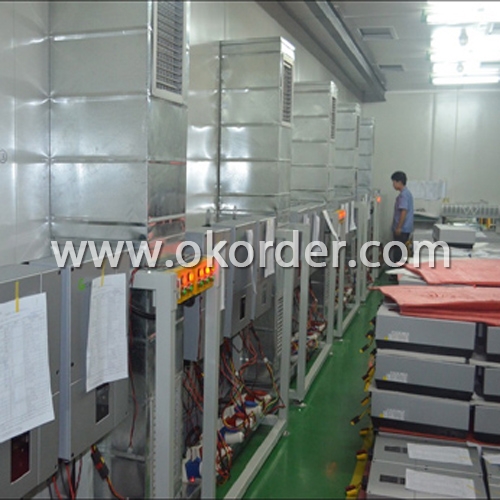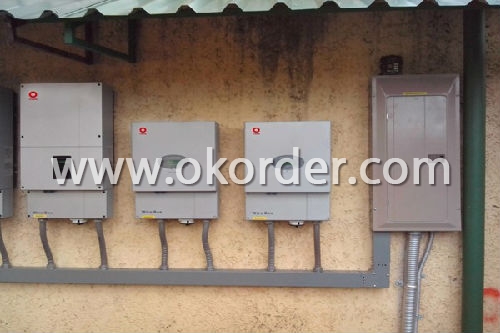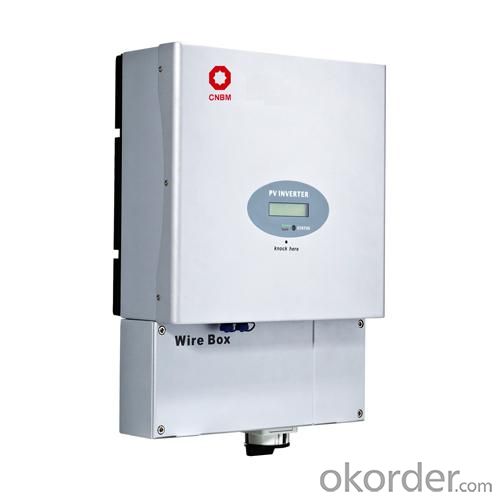3600W Grid Connected Solar Inverter with Battery and Solar Panel
- Loading Port:
- Shenzhen
- Payment Terms:
- TT or LC
- Min Order Qty:
- 1 Unit pc
- Supply Capability:
- 5000Units/per month pc/month
OKorder Service Pledge
OKorder Financial Service
You Might Also Like
What we have, what we can offer
With a R&D team more than 100 engineers,40% of the staff, who has been deeply engaged in the photovoltaic industry for 10 years, CNBM takes the mission to increase the inverter availability and efficiency, putting continuous innovation to make CNBM inverter easier for installation and operation, and more cost-effective for solar plant construction. The full range of CNBM single phase inverters has received VDE, CE, G83/1, G59/2, ENEL2010, VDE4105, C10/C11, AS4777 etc. Maximum efficiency of 97.8% and wide input voltage range, Internal DC switch, MTL-String, Sound control, Bluetooth/RF technology /Wi-FiTransformerless, GT topology.
The range of the Grid Connected Solar Inverter we can offer is from 1.5kw to 20kw.
Brief introduction of Grid Connected U.S. Solar Inverter 3600W
Maximum efficiency of 97.5% and wide input voltage range
Integrated DC switch-disconnected
MTL-String
Sound control
Bluetooth/RF technology /Wi-Fi
Transformerless GT topology
5 years warranty (10 years as optional)
Specification of Grid Connected U.S. Solar Inverter 3600W
Model | CNBM-3600MTL-US | CNBM-4200MTL-US | CNBM-5000MTL-US |
Input data | |||
Max. DC power | 3800W | 4400W | 5200W |
Max. DC voltage | 600V | 600V | 600V |
Start voltage | 150V | 150V | 150V |
PV voltage range | 100V-600V | 100V-600V | 100V-600V |
Number of MPP trackers/strings per MPP tracker | 2/2 | 2/2 | 2/2 |
Max. input current of the MPP tracker | 12A | 15A | 15A |
Output data | |||
Nominal AC output power | 3600W | 4200W | 4600W |
Max. output current | 18/17.1A/14.8A | 21A/20A/17.2A | 22A/23.7A/20.5A |
AC nominal voltage; range | Default:240V single phase optional:208,240or277 single phase 183-228@208V 211-264V@240V 244-305@277V | ||
AC grid frequency; range | 60Hz;59.3-60.5Hz | 60Hz;59.3-60.5Hz | 60Hz;59.3-60.5Hz |
Phase shift (cosφ) | 1 | 1 | 1 |
THDI | <3% | <3% | <3% |
AC connection | Single phase | Single phase | Single phase |
Efficiency | |||
Max. efficiency | 98% | 98% | 98% |
CEC efficiency | 97% | 97% | 97% |
MPPT efficiency | 99.5% | 99.5% | 99.5% |
Protection devices | |||
Output overvoltage protection-varistor | yes | yes | yes |
Ground fault monitoring | yes | yes | yes |
Grid monitoring | yes | yes | yes |
General Data | |||
Dimensions (W / H / D) in mm | 360/650/188 | 360/650/188 | 360/650/188 |
Weight | 28.3KG | 28.3KG | 28.3KG |
Operating temperature range | -25...+60°C | -25...+60°C | -25...+60°C |
Altitude | Up to 2000m(6560ft) without power derating | ||
Relative humidity | 95% | ||
Consumption: operating(standby) / night | <5W / < 0.5 W | <5W / < 0.5 W | <5 W / < 0.5 W |
Topology | Transformerless | ||
Cooling concept | Natural | Natural | Natural |
Enclosure | Type 3R | Type 3R | Type 3R |
Features | |||
DC connection: | Screw terminal | Screw terminal | Screw terminal |
AC connection: | Screw terminal | Screw terminal | Screw terminal |
display | LCD | LCD | LCD |
Interfaces: RS485/RS232/Bluetooth/RF/Zigbee | yes/yes/opt/opt/opt | ||
Warranty: 10 years / 15 years | yes /opt | yes /opt | yes /opt |
Certificates and approvals | UL1741,UL1998 IEEE 1547, CSA C22.2 No.107.1-1,FCC Part15(Class A&B) | ||
Picture 1: Factory of Grid Connected U.S. Solar Inverter 3600W

Picture 2: Installation reference of Grid Connected U.S. Solar Inverter 3600W

- Q: How do you calculate the maximum power point current for a solar inverter?
- To calculate the maximum power point current for a solar inverter, you need to determine the optimal operating voltage and current at which the solar panel can produce the maximum power. This can be done by using a technique known as the perturb and observe (P&O) algorithm. The P&O algorithm continuously adjusts the operating point of the solar panel by slightly perturbing the voltage and observing the resulting change in power. By tracking the voltage and current values that yield the highest power output, you can calculate the maximum power point current for the solar inverter.
- Q: How does a solar inverter work?
- A solar inverter works by converting the direct current (DC) electricity produced by solar panels into alternating current (AC) electricity that can be used to power household appliances and be connected to the electric grid. It also ensures that the solar panels operate at their maximum efficiency by tracking the maximum power point and optimizing the power output.
- Q: How does a solar inverter handle voltage regulation during fault conditions?
- A solar inverter handles voltage regulation during fault conditions by quickly detecting any abnormal voltage fluctuations or faults in the system. It then uses various protective mechanisms such as voltage control algorithms, circuit breakers, and fault detection systems to prevent overvoltage or undervoltage situations. The inverter may also isolate itself from the grid to avoid any potential damage or safety hazards.
- Q: Grid-connected inverter is generally divided into photovoltaic power generation grid-connected inverter, wind power grid-connected inverter, power equipment and grid-connected inverter and other power generation equipment power generation inverter.
- Grid-connected inverter is generally used with large-scale photovoltaic power plant system, a lot of parallel PV string is connected to the same set of inverter DC input, the general power of the use of three-phase IGBT power module, power
- Q: How does a solar inverter synchronize with the grid?
- A solar inverter synchronizes with the grid by continuously monitoring the grid's voltage and frequency. It adjusts its own voltage and frequency accordingly to match the grid, allowing the solar power to flow seamlessly into the grid. This synchronization is important to ensure the safe and efficient operation of the solar power system, as well as to prevent any disturbances or damage to the grid.
- Q: Are solar inverters weather-resistant?
- Yes, solar inverters are typically weather-resistant. They are designed to withstand different weather conditions such as rain, snow, and extreme temperatures. However, it is still important to consider proper installation and maintenance to ensure the longevity and performance of the inverter in varying weather conditions.
- Q: Can a solar inverter be used with different types of mounting systems?
- Yes, a solar inverter can be used with different types of mounting systems. The compatibility of the inverter with different mounting systems depends on factors such as the voltage and power requirements, as well as the communication protocols. However, most modern solar inverters are designed to be versatile and can be used with various types of mounting systems, including roof-mounted, ground-mounted, and pole-mounted systems.
- Q: Can a solar inverter be used with a net metering system?
- Yes, a solar inverter can be used with a net metering system. In fact, a solar inverter is an essential component of a net metering system. It converts the direct current (DC) electricity generated by the solar panels into alternating current (AC) electricity that can be used to power the home or business. The excess electricity produced by the solar panels is fed back into the grid through the net meter, allowing the utility company to credit the owner for the excess energy produced.
- Q: How does a solar inverter synchronize with the electrical grid?
- A solar inverter synchronizes with the electrical grid by constantly monitoring the voltage and frequency of the grid. It adjusts its own output voltage and frequency to match the grid's, ensuring that the electricity generated by the solar panels is in phase and synchronized with the grid. This synchronization allows the solar power to be seamlessly integrated into the grid, enabling efficient power transfer and preventing any disruption to the supply.
- Q: What is the maximum DC input voltage for a solar inverter?
- The maximum DC input voltage for a solar inverter typically depends on the specific model and manufacturer. However, in general, the maximum DC input voltage for a solar inverter can range from around 500 volts to 1000 volts or more. It is important to consult the manufacturer's specifications for the specific solar inverter being used to determine the exact maximum DC input voltage.
Send your message to us
3600W Grid Connected Solar Inverter with Battery and Solar Panel
- Loading Port:
- Shenzhen
- Payment Terms:
- TT or LC
- Min Order Qty:
- 1 Unit pc
- Supply Capability:
- 5000Units/per month pc/month
OKorder Service Pledge
OKorder Financial Service
Similar products
Hot products
Hot Searches
Related keywords


























